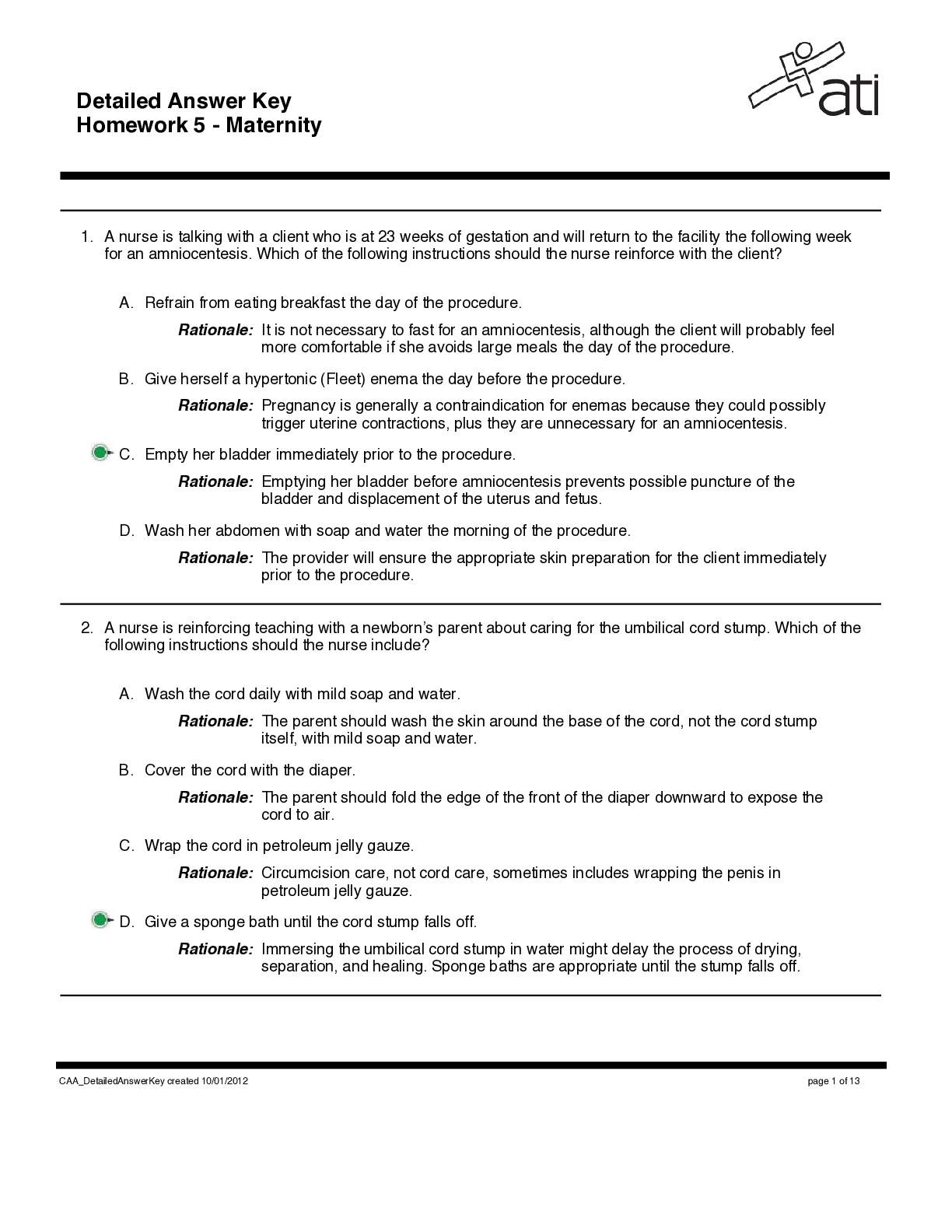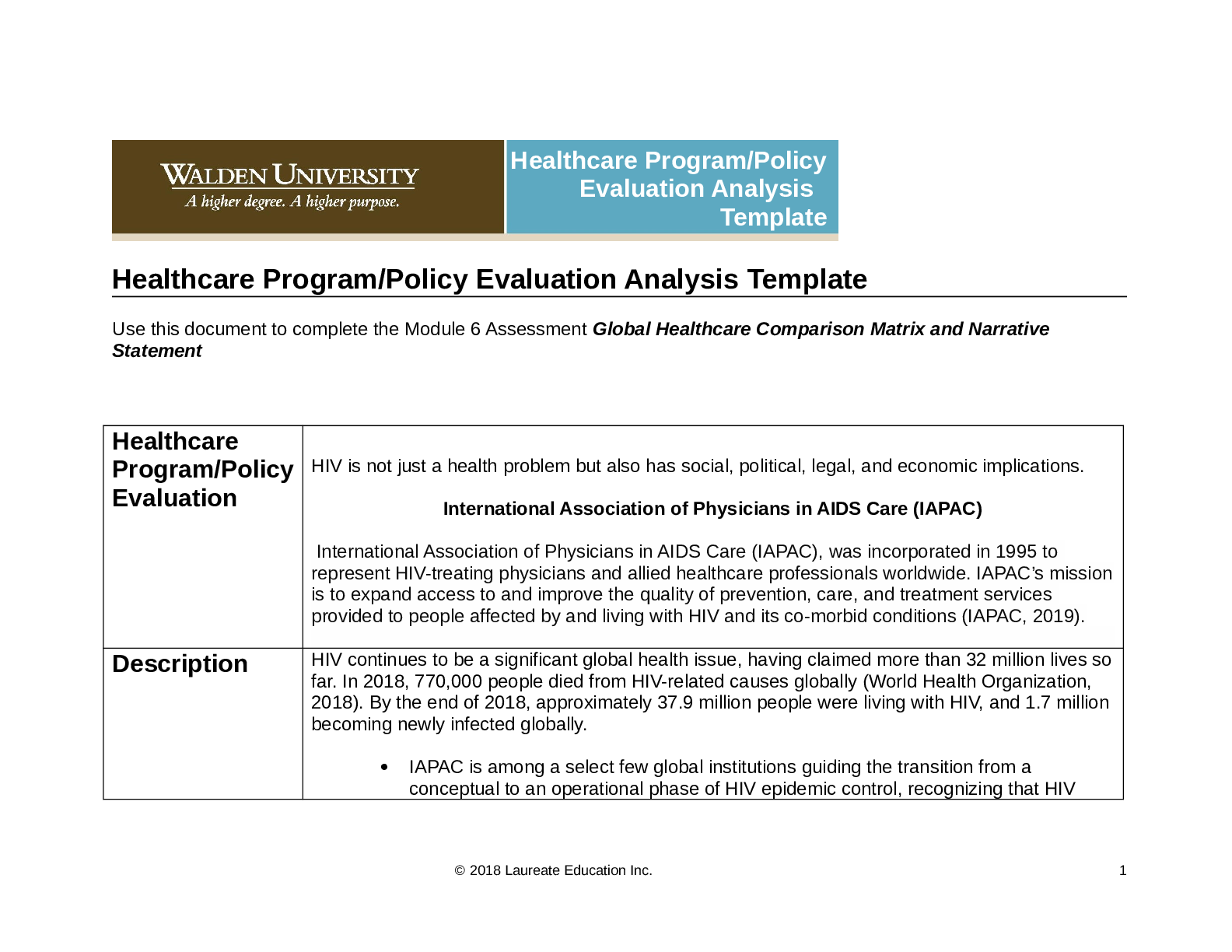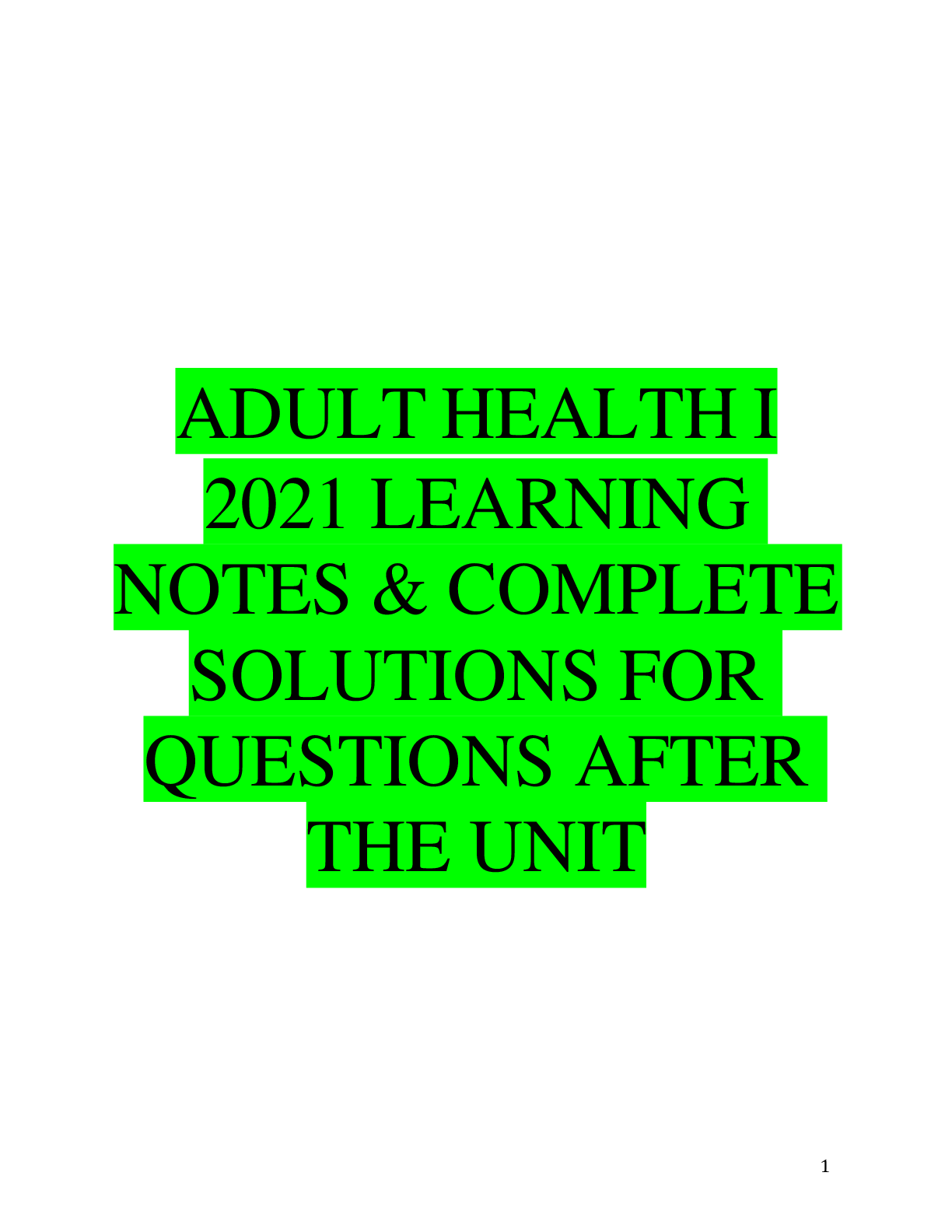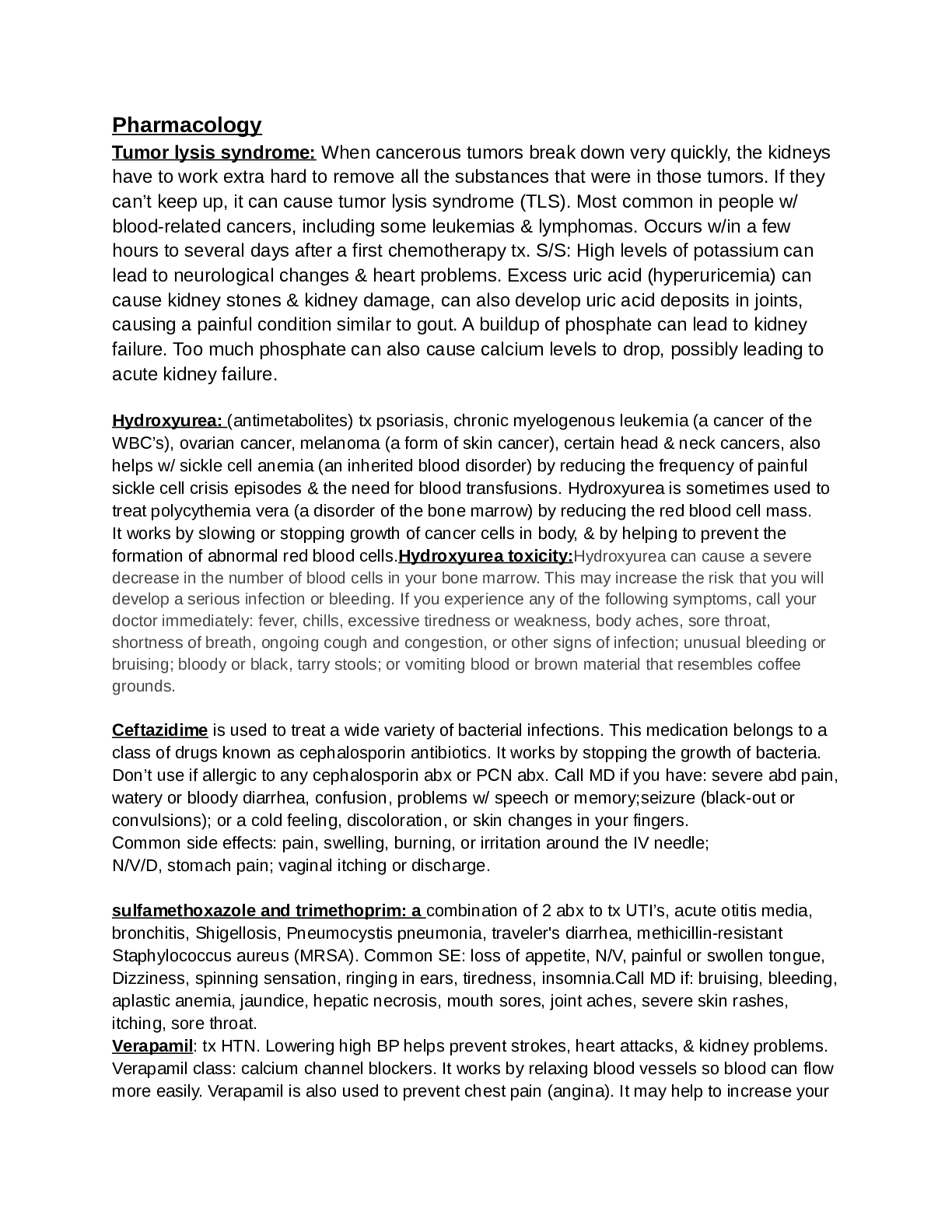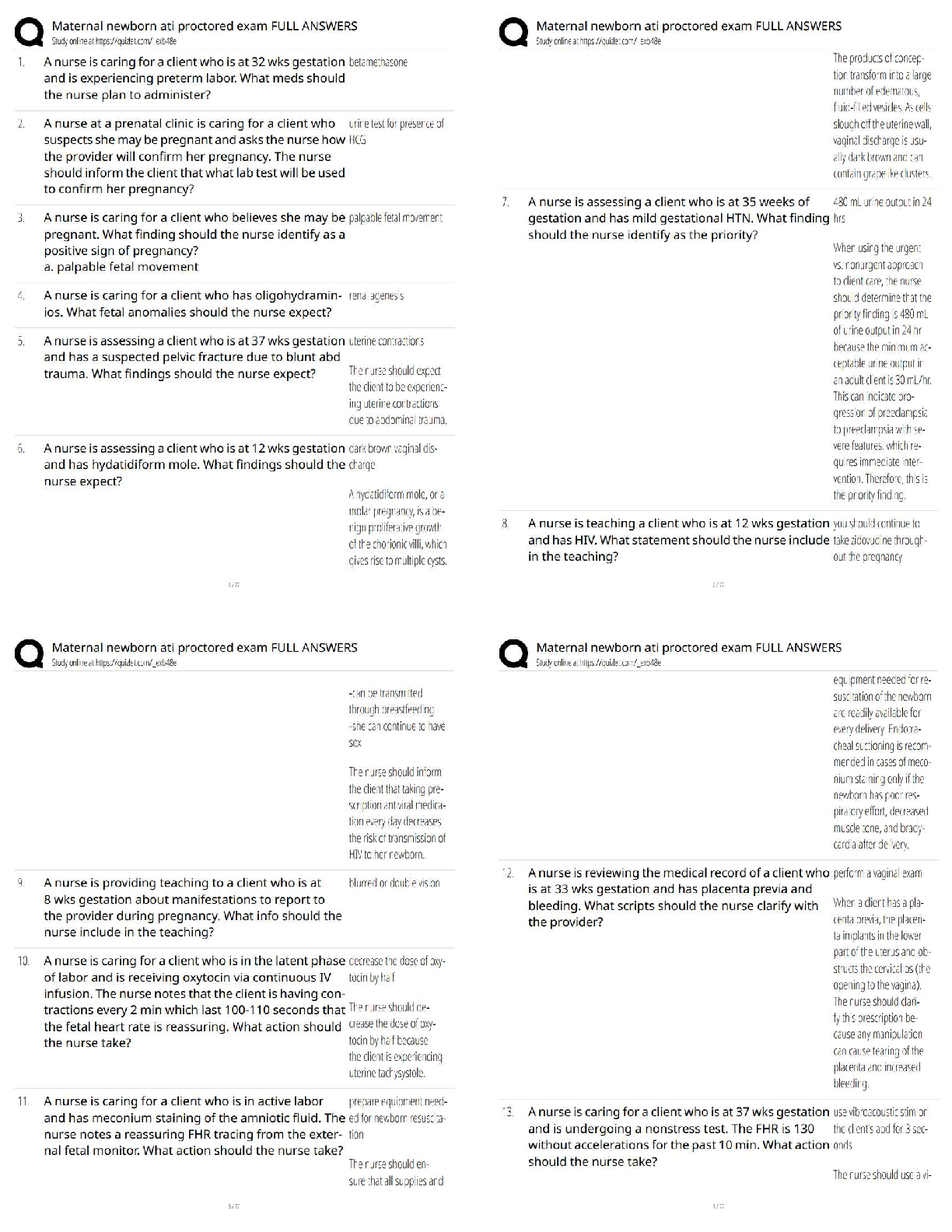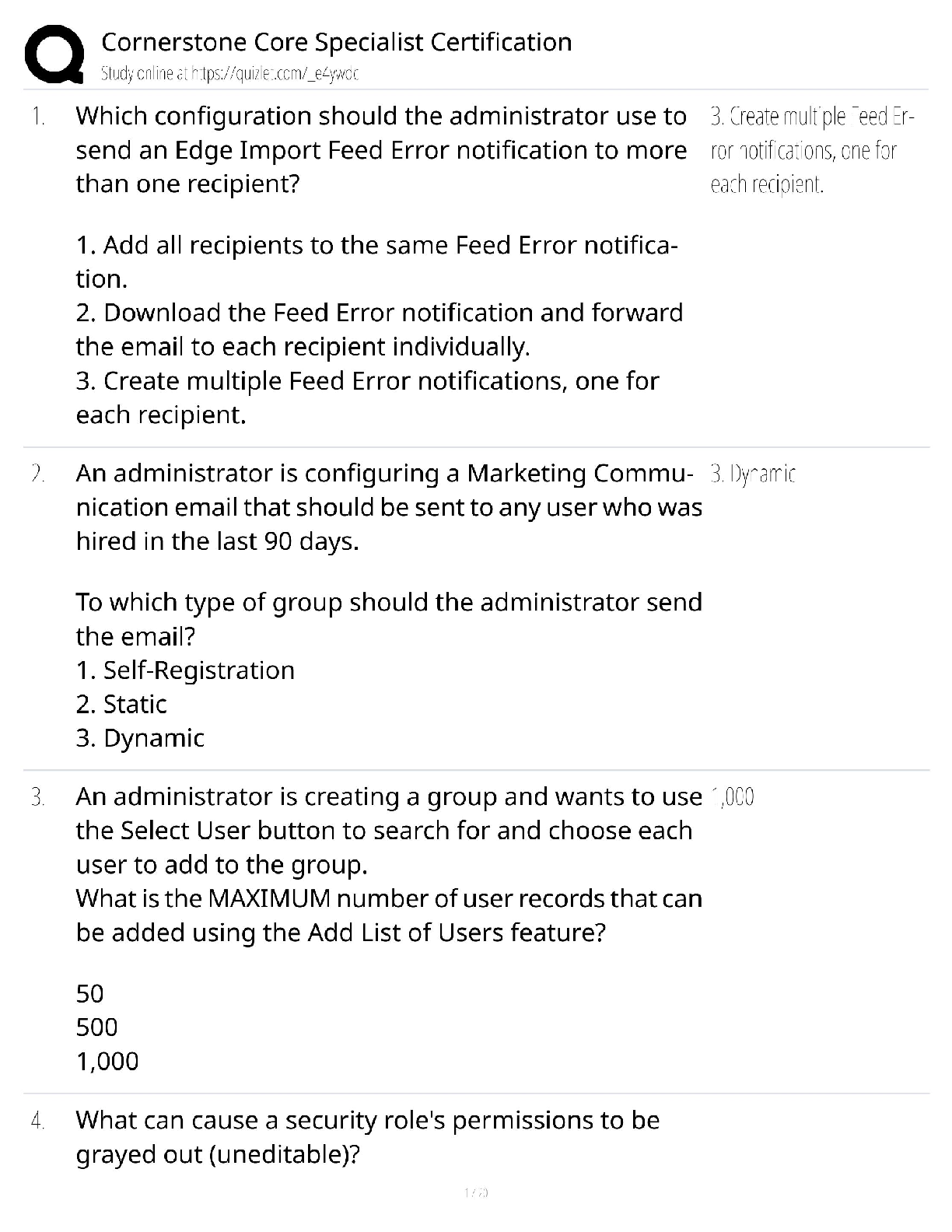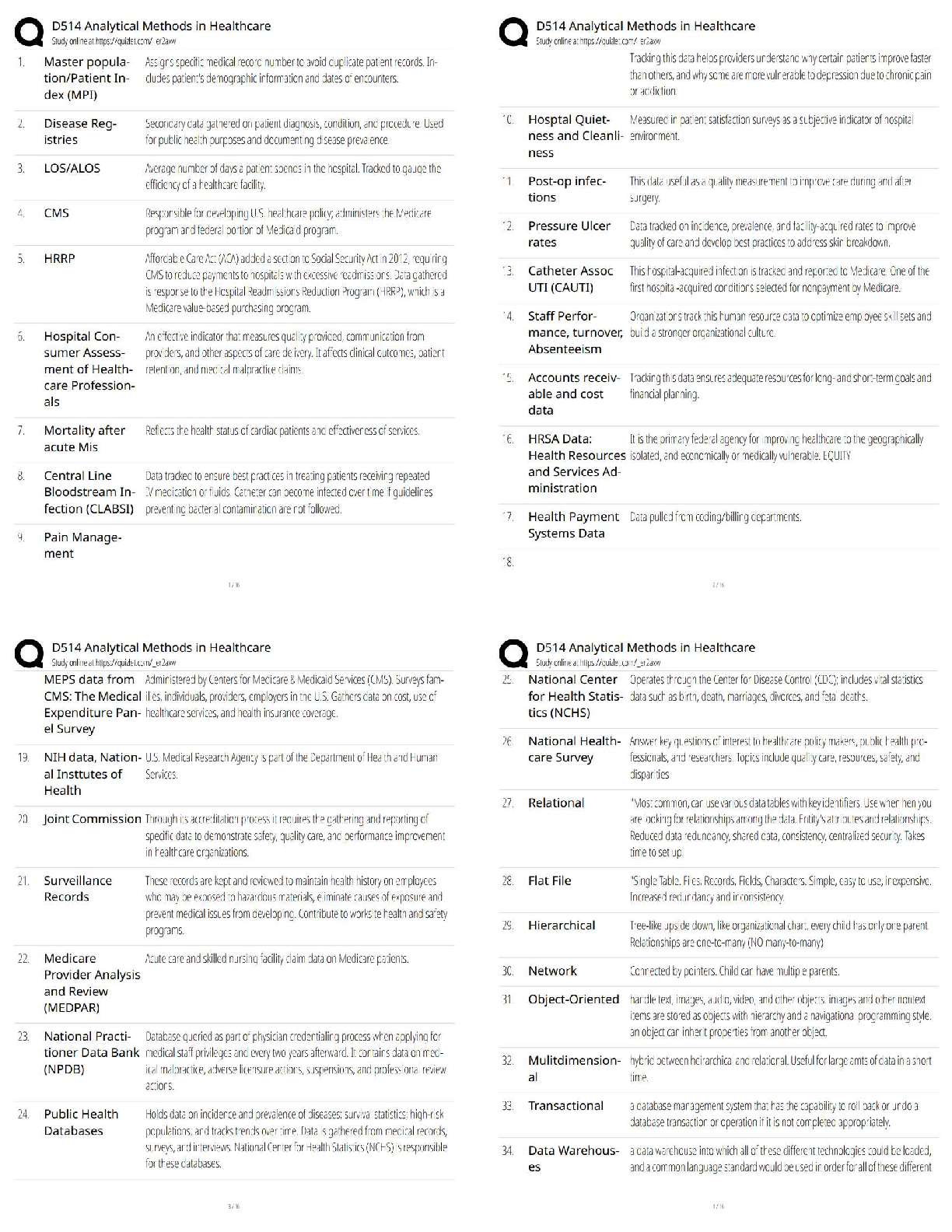*NURSING > QUESTIONS and ANSWERS > ATI PROTOCORED COMPREHENSIVE ADDITIONAL REVIEW Q & A BY DIFFRENT LEARNERS RATED BEST AND 100% CORREC (All)
ATI PROTOCORED COMPREHENSIVE ADDITIONAL REVIEW Q & A BY DIFFRENT LEARNERS RATED BEST AND 100% CORRECT, ACE YOUR REVISION
Document Content and Description Below
“Coming together is a beginning; keeping together is progress; working together is SUCCESS” DUE Friday 8/18 @ 1500 FYI numbers that are highlighted in yellow are confirmed ✓→ typed ✅→ co ... mpleted w/ rationale Main Priority ➔ 2016: Utilize all ATI resource you have. Stay organized. Don't Panic. Stop, drop and roll as needed. 1. Christine (1-10) ✅ 2.Kristine (11-20)✓ 3. Lorena (21-30)✓ 4. Chiugo (31-40)✓ 5. Rukhsar (41-50)✓ 6. Michael (51-60) ✅ 7. Kourtney (61-70) ✓ 8. Laura (71-80)✓ 9. Dio (81-90)✅ 10. Daniel (91-100) ✅ 11. Shaunte (101-110)✓ 12. Navjot (111-120) ✅ 13. Philip(121-130) ✅ 14. Julie (131-140)✓ 15. Sara (141-150) ✅ 16. Jacqueline H.(151-160) ✓ 17. Brian(161-170)✓ 18. Robin (171-180)✓ Verify all answers: COMPREHENSIVE 2 Ryan, Paul & Jackie → 1-90 Camille, Kate & Jo → 91-180 1. Missing 2. A nursing planning care for a school-age child who is 4 hrs. postoperative following perforated appendicitis. Which of the following actions should the nurse include in the plan of care? a. Offer small amounts of clear liquids 6 hrs. following surgery (assess for gag reflex first) b. Give cromolyn nebulizer solution every 6 hrs. (for asthma) c. Apply a warm compress to the operative site every 4 hrs. d. Administer analgesics on a scheduled basis for the first 24 hrs. Rationale Fundamentals ATI PDF p229: Managing acute severe pain with short‑term (24 to 48 hrs.) around‑the‑clock administration of opioids is preferable to following a PRN schedule. ATI PEDS 144 Maintain NPO. Administer IV fluids and antibiotics as prescribed. NO cromolyn nebulizer stated on ATI. 3. A nurse is receiving change-of-shift report for a group of clients. Which of the following clients should the nurse plan to assess first? a. A client who has sinus arrhythmia and is receiving cardiac monitoring b. A client who has diabetes mellitus and a hemoglobin A1C of 6.8% c. A client who has epidural analgesia and weakness in the lower extremities d. A client who has a hip fracture and a new onset of tachypnea Rationale Med Surg ATI PDF p457: s/s of fat embolism (dyspnea, increased RR, decreased O2, headache, decreased LOC r/t low O2 levels, respiratory distress, tachycardia, confusion, chest pain), Hip and pelvis fractures are common causes, can occur after injury usually within 12-48 hrs. 4. A nurse is preparing to apply a transdermal nicotine patch for a client. Which of the following actions should the nurse take? a. Shave hairy areas of skin prior to application (apply to hairless, clean & dry areas to promote absorption; avoid oily or broken skin) b. Wear gloves to apply the patch to the client’s skin c. Apply the patch within 1 hr. of removing it from the protective pouch (apply immediately) d. Remove the previous patch and place it in a tissue (fold patch in half with sticky sides pressed together) Rationale https://medlineplus.gov/druginfo/meds/a601084.html: How to apply patch Rationale ATI Skills Module Medication Administration: Topical medications include lotions, creams, ointments, patches, and paste. Because topical medications are absorbed by the skin, wear gloves when applying them to protect yourself against accidental exposure Shaving may cause skin irritation and change the absorption of the drug. COMPREHENSIVE 3 5. A nurse has just received change-of-shift report for four clients. Which of the following clients should the nurse assess first? a. A client who was just given a glass of orange juice for a low blood glucose level b. A client who is schedule for a procedure in 1 hr. (can wait) c. A client who has 100 mL fluid remaining in his IV bag (can wait) d. A client who received a pain medication 30 min ago for postoperative pain Rationale Med Surg ATI PDF p529: assess for improvement or worsening of hypoglycemia. Repeat the administration of carbohydrates if not within normal limits, and recheck blood glucose in 15 min. Risk for seizure & coma if condition worsens. 6. A nurse is caring for a client who is receiving intermittent enteral tube feedings. Which of the following places the client at risk for aspiration? a. A history of gastroesophageal reflux disease b. Receiving a high osmolarity formula c. Sitting in a high-Fowler’s position during the feeding d. A residual of 65 mL 1hr postprandial Rationale ATI MS p309: Complications: Aspiration of gastric secretion Causes: Reflux of gastric fluids into the esophagus can be aspirated into the trachea. 7. A nurse is reviewing the laboratory results for a client who has Cushing’s disease. The nurse should expect the client to have an INCREASED in which of the following laboratory values? a. Serum glucose level- increased b. Serum calcium level-decreased c. Lymphocyte count- decreased immune system. d. Serum potassium level- decreased Rationale ATI MS PDF p518: Cushing disease→ everything is UP except Potassium & Calcium: DECREASED. 8. A nurse is caring for a client who has severe preeclampsia and is receiving magnesium sulfate intravenously. The nurse discontinues the magnesium sulfate after the client displaces toxicity. Which of the following actions should the nurse take? P . 235 pharm Ch. 30 a. Position the client supine b. Prepare an IV bolus of dextrose 5% in water c. Administer methylergonovine IM d. Administer calcium gluconate IV Rationale ATI PHARM PDF p398: Calcium gluconate is given for magnesium sulfate toxicity. Always have an injectable form of calcium gluconate available when administering magnesium sulfate by IV. 9. A charge nurse is teaching new staff members about factors that increase a client’s risk to become violent. Which of the following risk factors should the nurse include as the best predictor of future violence? COMPREHENSIVE 4 a. Experiencing delusions b. Male gender c. Previous violent behavior d. A history of being in prison Rationale ATI MH p185: Risk factors also include: history of aggression, poor impulse control, and violence. Comorbidity that leads to acts of violence (psychotic delusions, command hallucinations, violent angry reactions with cognitive disorders). Rationale ATI COMMUNITY p50: Individual Assessment for Violence 10. A nurse is preparing to perform a sterile dressing change. Which of the following actions should the nurse take when setting up the sterile field? a. Place the cap from the solution sterile side up on clean surface b. Open the outermost flap of the sterile kit toward the body→ flap AWAY from the body's first c. Place the sterile dressing within 1.25 cm (0.5in) of the edge of the sterile field → 2.5 cm (1-inch) border around any sterile drape or wrap that is considered contaminated. d. Set up the sterile field 5 cm (2 in) below waist level→ it says BELOW waist level; should be ABOVE waist level Rationale POTTER & PERRY SKILLS & TECH p187: Remove sterile seal and cap from bottle in upward motion. 11. A nurse is providing teaching to an older adult client about methods to promote nighttime sleep. Which of the following instructions should the nurse include? a. Eat a light snack before bedtime b. Stay in bed at least 1 hr. if unable to fall asleep c. Take a 1 hr. nap during the day d. Perform exercises prior to bedtime 12. A home health nurse is preparing for an initial visit with an older adult client who lives alone. Which of the following actions should the nurse take first? a. Educate the client about current medical diagnosis b. Refer the client to a meal delivery program c. Identify environmental hazards in the home d. Arrange for client transportation to follow-up appointments Rationale Priority: Assess first. 13. A nurse is assessing the remote memory of an older adult client who has mild dementia. Which of the following questions should the nurse ask the client? a. “Can you tell me who visited you today?” b. “What high school did you graduate from?” c. “Can you list your current medications?” COMPREHENSIVE 5 d. “What did you have for breakfast yesterday?” Rationale ATI How to assess “remote memory”? Have patient state a verifiable fact (e.g. birthdate). OR ask the client to state a fact from their past that is verifiable. Memory of events that occurred in the distant past. 14. A nurse is providing teaching to an adolescent who has type 1 diabetes mellitus. Which of the following goals should the nurse include in the teaching? P .528 med surg Ch. 82 a. HbA1c level greater than 8%- 6.5 - 8 is the target reference. > 8 means NON-COMPLIANT b. Blood glucose level greater than 200 mg/dL at bedtime c. Blood glucose level less than 60 mg/dL before breakfast- < 70 = HYPOGLYCEMIC d. HbA1c level less than 7% 15. A nurse is caring for a client who is receiving phenytoin for management of grand mal seizures and has a new prescription for isoniazid and rifampin. Which of the following should the nurse conclude if the client develops ataxia and incoordination? a. The client is experiencing an adverse reaction to rifampin b. The client’s seizure disorder is no longer under control d. The client is having adverse effects due to combination antimicrobial therapy Rationale: http://www.webmd.com/drugs/2/drug-4157/dilantin-oral/details#interactions Rationale ATI Pharm p96: Phenytoin complications include ataxia, sedation & cognitive impairment (http://emedicine.medscape.com/article/816447-clinical#b4 also states that this is an indication of phenytoin toxicity); According to my Davis Drug Guide book, progressive s/s of phenytoin toxicity include ataxia, nystagmus, confusion, nausea, slurred speech & dizziness. 16. A nurse is caring for a client who is 1 hr. postoperative following rhinoplasty. Which of the following manifestations requires immediate action by the nurse? a. Increase in frequency of swallowing→ may indicate bleeding b. Moderate sanguineous drainage on the drip pad c. Bruising to the face→ side effect d. Absent gag reflex→ possibly due to anesthesia given. (1 hour postoperative) Rationale “Requires immediate action” choose the worst possibility that could lead to. ABC 17. A nurse is planning care for a preschool-age child who is in the acute phase Kawasaki disease. Which of the following interventions should the nurse include in the plan of care? a. Give scheduled doses of acetaminophen every 6 hr. b. Monitor the child’s cardiac status c. Administer antibiotics via intermittent IV bolus for 24 hr. d. Provide stimulation with children of the same age in the playroom Rationale ATI PDF p: PEDS p. 120 Monitor VS, cardiac status. Maintain cardiac monitoring. Assess for HF (decrease urine output, gallop heart rhythm, tachycardia, respiratory distress) COMPREHENSIVE 6 Kawasaki disease cause inflammation in the walls of medium-sized arteries throughout the body. It primarily affects children. The inflammation tends to affect the coronary arteries, which supply blood to the heart muscle. 18. A nurse is planning an educational program for high school students about cigarette smoking. Which of the following potential consequences of smoking is most likely to discourage adolescents from using tobacco? a. Use of tobacco might lead to alcohol and drug abuse b. Smoking in adolescence increases the risk of developing lung cancer later in life c. Use of tobacco decreases the level of athletic ability d. Smoking in adolescence increases the risk of lifelong addiction Rationale ATI PDF p:33 PEDS Age appropriate activities for high school students: sports, video games, music, social events. 19. A nurse is assessing a client who is prescribed spironolactone. Which of the following laboratory values should the nurse monitor for this client? P . 146 Ch. 19 CONFIRMED a. Total bilirubin b. Urine ketones c. Serum potassium- diuretic that retains potassium= hyperkalemic risk d. Platelet count Rationale ATI PDF p: 146 Pharm Complications: hyperkalemia 20. A nurse has agreed to serve as an interpreter for an older adult client who is assigned to another nurse. Which of the following statements by the nurse indicates an understanding of this role? a. “I will let the client know that I am available as the interpreter.” b. “I will receive a small fee for interpreting for this client.” c. “I am glad I’m available today, but when I’m not, you can use a family member.” d. “I will let the client know that an interpreter is unavailable during the night shift.” Rationale ATI PDF p: Makes most sense 21. A nurse is performing assessments on newborns in the nursery. Which of the following findings should the nurse report to the provider? P . 156 Ch. 23 MATERNITY PDF a. A two-day old newborn who has a respiratory rate of 70 --> 30 - 60 is normal they can be is RESPIRATORY DISTRESS b. A 16-hour old new newborn who has yet to pass meconium- you got 24 hours to pass stool c. A 2-day old newborn who has a small amount of blood tinged vaginal discharge d. A 16-hr. old newborn whose blood glucose is 45 mg/dl- 40 - 60 is normal 22. A nurse on an acute unit has received change of shift report for 4 clients which of the following clients should the nurse assess first? Pain pallor pulslessness paresthesia a. A client who is 1 hr. postoperative and has hypoactive bowel sounds COMPREHENSIVE 7 b. A client who has fractured left tibia and pallor in the affected extremity c. A client who had a cardiac catheterization 3 hr. ago and has 3+ pedal pulses d. A client who has an elevated AST level following administration of azithromycin Rationale: circulation is affected; ABCs 23. A nurse is providing discharge instructions to a client who has a new prescription for haloperidol which of the following adverse effects should the nurse instruct the client to report to the provider? a. Dry mouth→ anticholinergic effects b. Sedation → c. Shuffling gait →A/E EPS: is an indication of parkinsonism and should be reported to the provider. ATI PHARM 110 Rationale: e book pg. 69 Ch. 10 24. A nurse is planning discharge teaching about cord care for the parents of a newborn which of the following instructions should the nurse plan to include in the teaching? P . 177 Ch. 26 a. Clean the base of the cord with hydrogen peroxide daily- only with tub and sponge baths b. The cord stump will fall off in 5 days- about 10 - 14 days c. Contact the provider if the cord stump turns black d. Keep the cord stump dry until it falls off Rationale: cord usually falls out within 7 to 10 days. Clean with soap and water. Cord is expected to turn black and dry. 25. A nurse is teaching dietary guidelines to a client who has celiac disease which of the following food choices is appropriate for the client? a. White flour tortillas b. Potato pancakes c. Wheat crackers d. Canned barley soup Rationale: no wheat, flour, or barley 26. A nurse is working in acute care mental health facility is assessing a client who has schizophrenia. Which of the following findings should the nurse expect? a. All or nothing thinking b. Euphoric mood c. Disorganized speech → alterations in speech d. Hypochondriasis ( anxiety disorder) pg. 108 eBook Ch. 20 Rationale : e book pg. 79 under expected findings Ch. 15 COMPREHENSIVE 8 27. A nurse is caring for a client who is immobile which of the following interventions is appropriate to prevent contracture? a. Align a trochanter wedge between the client’s legs b. Place a towel roll under the client’s neck c. Apply an orthotic to the client’s foot d. Position a pillow under the client's knees Rationale: Casting or splinting techniques are used to provide a constant stretch to the soft tissues surrounding a joint. It is most effective when used to increase motion of a joint from prolonged immobilization. It is also popular for treating contractures resulting from an increase in muscle tone from nerve injury. After an initial holding cast is applied for seven to 10 days, a series of positional casts are applied at weekly intervals. Before the application of each new cast, the joint is moved as much as can be tolerated by the patient, and measured by a goniometer. When as much motion as possible is obtained after stretching, another final cast is applied to maintain the newly acquired motion. 28. A public health nurse working in a rural area is developing a program to improve health for the local population. Which of the following actions should the nurse plan to take? a. Provide anticipatory guidance classes to parents through public schools b. Have a nurse from the outside the community provide health lectures at the county hospital c. Encourage rural residents to focus health spending on tertiary health interventions d. Launch a media campaign to increase awareness about industrial pollution 29. A nurse in the emergency department is performing triage for multiple clients following a disaster in the community. To which of the following types of injuries should the nurse assign the highest priority? a. Below the knee amputation → ESI Level 1 b. 10cm (4 in) laceration → ESI Level 4 c. Fractured tibia → ESI Level 2; if pelvis, femur, or hip and other extremity dislocation then level 1. d. 95% full thickness body burn → ESI Level 2 required immediate pain control per Triage, hypotension with signs of hypo perfusion. -Patients with signs and symptoms of compartment syndrome are at high risk for extremity loss and should be assigned ESI level 2. Other patients with high-risk orthopedic injuries include any extremity injury with compromised neurovascular function, partial or complete amputations, or trauma mechanisms identified as having a high risk of injury such as serious acceleration, deceleration, pedestrian struck by a car, and gun shot or stab wound victims. Patients with possible fractures of the pelvis, femur, or hip and other extremity dislocations should be carefully evaluated and vital signs considered. These fractures can be associated with significant blood loss. Again, hemodynamically unstable patients who need immediate life-saving intervention such as high-level amputations meet ESI level-1 criteria. High level amputations meet ESI level 1. COMPREHENSIVE 9 -Patients with inhalation injuries from closed space smoke inhalation or chemical exposure should be considered high-risk for potential airway compromise. If the patient presents with significant airway distress and requires immediate intervention, they meet level-1 criteria. Patients with third-degree burns should also be considered high-risk and be assigned ESI level 2. It is possible that they will require transfer to a burn center for definitive care. 30. A nurse is preparing a change of shift report for an adult female client who is postoperative. Which of the following client information should the nurse include in the report? CONFIRMED a. Hgb 12.8 g/dl - 12- 16 b. Potassium 4.2 mEq/l 3.5 - 5.0 mEq c. RBC 4.4 million/mm3 d. Platelets 100,000/mm3 - 150,000 - 300,000 risk for bleeding Rationale: all other options are okay; except the platelets which is in an abnormal range. 31. A nurse is admitting a client who has anorexia nervosa. Which of the following is an expected finding? a. Iron 90 mcg/dl b. Prealbumin 10 mcg/dl (normal: 16-40) c. Serum creatinine 0.8 mg/dl d. Calcium 95 mg/dl Rationale: Prealbumin is low (normal is 18-36). Prealbumin = nutritional status ATI MH 111 Hypoalbuminemia 32. A charge nurse on a medical-surgical unit is planning assignments for a licensed practical nurse (LPN) who has been sent from the postpartum unit due to a staffing shortage for the shift. Which of the following client assignments should the nurse delegate to the LPN? a. A client who is postoperative following a bowel resection with an NGT set to continuous suction b. A client who has fractured a femur yesterday and is expecting SOB c. A client who sustained a concussion and has unequal pupils d. A client who has an Hgb of 6.3 g/dl and a prescription for packed RBCs 33. A nurse is caring for a client who is at 41 weeks of gestation and is receiving oxytocin for labor induction. The nurse notes early deceleration on the fetal heart rate monitor . Which of the following nursing actions should the nurse take ? p . 88 Ch. 13 maternity a. Continue to monitor the fetal heart rate- - Not a problem- absent or late are a problem however CONFIRMED b. Stop the oxytocin infusion c. Perform a vaginal examination d. Initiate an amnioinfusion COMPREHENSIVE 10 34. A nurse is conducting an initial assessment of a client and noticed a discrepancy between the client’s current IV infusion and the information received during the shift report. Which of the following actions should the nurse take? a. Complete an incident report and place it in the client's medical record. b. Compare the current infusion with the prescription in the client's medication record. c. Contact the charge nurse to see if the prescription was changed. d. Submit a written warning for the nurse involved in the incident. 35. A nurse is reviewing the medical record of a client who has schizophrenia and is taking clozapine. Which of the following findings should the nurse identify as a contraindication to the administration of clozapine ? a. WBC count 2,900 /mm3 - AGRANULOCYTOSIS - 4,800- 15,000 is normal range b. Fasting blood glucose 100 mg/dl c. Hgb 14 g/Dl d. Heart rate 58/min ATI PHARM 116 Complications 36. A nurse is caring for a client who is at 38 weeks of gestation and has a history of hepatitis C. The client asks the nurse if she will be able to breastfeed. Which of the following responses by the nurse is appropriate? a. You may breastfeed unless your nipples are cracked or bleeding. b. You must use a breast pump to provide breast milk. c. You must use nipple shield when breastfeeding. d. You may breastfeed after your baby develops his antibiotics. Rationale: CDC states that: There is no documented evidence that breastfeeding spreads HCV. Therefore, having HCV-infection is not a contraindication to breastfeed. HCV is transmitted by infected blood, not by human breast milk. There are no current data to suggest that HCV is transmitted by human breast milk. However, HCV is spread by infected blood. Therefore, if the HCV-positive mother’s nipples and/or surrounding areola are cracked and bleeding, she should stop nursing temporarily. Instead, she should consider expressing and discarding her breast milk until her nipples are healed. Once her breasts are no longer cracked or bleeding, the HCV-positive mother may fully resume breastfeeding. 37. A nurse is caring for a client who has returned to the medical-surgical unit following a transurethral resection of the prostate. Which of the following should the nurse identify as priority nursing assessment after reviewing the client’s information? Exhibit. a. Level of consciousness. b. Skin turgor c. Deep-tendon reflexes d. Bowel sounds Exhibit is not available to choose an answer. 38. A nurse is caring for a client who has hyperthermia .Which of the following actions for the nurse to take ? COMPREHENSIVE 11 a. Submerge the adolescent feet in ice water b. Cover the adolescent with a thermal blanket → if hypothermia. c. Administer oral acetaminophen d. Initiate seizure precautions Rationale: Hyperthermia occurs when a person's body temperature rises and remains above the normal; 98.6°F Most frequently, this occurs during the heat of summer and among the elderly. However, it may also be triggered by other medical conditions or certain medications. Rapid cooling may be the single most important action to prevent death or permanent disability. To mitigate organ damage, the goal should be to reduce rectal temperature to below 40°C within 30 minutes of beginning cooling therapy. The question does not indicate whether it is malignant hyperthermia which could have been caused by a medication. The question simply asks that the person has hyperthermia. 39. A nurse manager is updating protocols for belt restraints. Which of the following guidelines should the nurse include? a. Document the client's conditions every 15 minutes b. Attach the restraints to the beds side rails c. Request a PRN restraints prescription for clients who are aggressive d. Remove the client restraints every 4 hours 40. A nurse in emergency department is caring for a client who has full thickness burn of the thorax and upper torso. After securing the client's airway, which of the following is the nurse's priority intervention? P. 482 Ch. 75 CONFIRMED a. Providing pain management b. Offering emotional support c. Preventing infection d. Initiating IV fluid resuscitation - they are at risk for hypovolemic shock d/t 3rd spacing 41. A nurse is caring for a client who has cancer and is being transferred to hospice care. The client’s daughter tells the nurse, “I’m not sure what to say to my mom if she asks me about dying.” Which of the following responses by the nurse is appropriate? (SATA) A. Hospice will take good care of your mom, so I wouldn’t worry about that. B. Let's talk about your mom’s cancer and how things will progress from here. C. Tell me how you are feeling about your mom dying. D. Tell her not to worry. She still has plenty of time left. E. You sound like you have questions about your mom dying. Let’s talk about it. Rationale: 42. A nurse is reviewing the medical records of four clients. The nurse should identify that which of the following client findings follow up care? a. A client who is taking bumetanide and has potassium level of 3.6 mEq/L COMPREHENSIVE 12 b. A client who is scheduled for colonoscopy and taking sodium phosphate c. A client who received a Mantoux test 48 hours ago and has induration d. A client who is taking warfarin and has INR of 1.8 43. A community health nurse receives a referral for a family home visit. Which of the following tasks should the nurse perform first? a. Clarify the source of the referral b. Implement the nursing process c. Schedule a time for the home visit d. Contact the family by phone 44. A nurse is caring for a client who will undergo a procedure. The client states he does not want the provider to discuss the results with his partner. Which of the following is an appropriate response for the nurse to make? a. You have the right to decide who receives information - HIPPA rules b. Your partner can be a great source of support for you at this time c. Is there a reason you don’t want your partner to know about your procedure? d. The provider will be tactful when talking to your partner 45. A nurse is discussing a weight loss with a client who is concerned about losing 6.8 kg (15lb) from an original weight of 9o.7 (200 lbs.). The nurse should identify the weight of the following total percentage? a. 7.5% b. 15% c. 8.1% d. 13.3% 46. A nurse is caring for a client who is 4 hrs. postpartum and reports that she cannot urinate. Which of the following interventions should the nurse implement? a. Perform fundal massage b. Pour water from a squeeze bottle over the client’s perineal area. c. Insert an indwelling urinary catheter. d. Apply cold therapy to the client’s perineal area. 47. A nurse is providing discharge teaching to a client who has cancer and a prescription for a fentanyl 25 mcg/hr. transdermal patch. Which of the following instructions should the nurse include in the teaching? a. Avoid hot tub while wearing the patch b. Apply patch to your forearm c. Avoid high-fiber foods while taking this medication d. Remove the patch for 8 hours every day to reduce the risk for tolerance. COMPREHENSIVE 13 *48. A nurse working on a surgical unit is developing a care plan for a client who has paraplegia. The client has an area of non-blanchable erythema over his ischium. Which of the following interventions should the nurse include in the care plan? a. Teach the client to shift his weight every 15 min while sitting (cannot do this because he is paraplegic) b. Place the client upright on a donut-shaped cushion c. Assess pressure points every 24 hr. d. Turn and reposition the client every 3 hrs. while in bed. Rationale: impairment or loss of motor or sensory function in areas of the body served by the thoracic, lumbar, or sacral neurological segments owing to damage of neural elements in those parts of the spinal column. It spares the upper limbs but, depending on the level, may involve the trunk, pelvic organs, or lower limbs. 49. A nurse is working with a client who has an anxiety disorder and is in the orientation phase of the therapeutic relationship. Which of the following statements should the nurse make during this phase? a. We should discuss resources to implement in your daily life b. Let me show you simple relaxation exercises to manage stress. c. Let’s talk about how you can change your response to stress d. We should establish our roles in the initial session. 50. A nurse is providing discharge teaching to a client who has a new prescription for phenelzine. The nurse should instruct the client that it is safe to eat which of the following foods while taking this medication? a. Avocados b. Whole grain bread c. Pepperoni pizza d. Smoked salmon Rationale: MAOIs = antidepressants; avoid foods with high tyramine content (egg, aged cheeses, sour cream, red wines, beer, bologna, pepperoni, salami, summer sausage, pickled herring, liver, meat prepared with tenderizers, canned figs, raisins, bananas, avocados, soy sauce, fava beans, yeast extracts), drink alcohol, or consume large quantities of caffeine (coffee, tea, chocolate, or cola) 51. A nurse enters a client’s room and sees a small fire in the client’s bathroom. Identify the sequence of steps the nurse should take. (Move the steps into the box on the right, placing them in the selected order of performance. Use all steps) a. Transport the client to another area of the nursing unit (1) b. Activate the facility’s fire alarm system (2) c. Close all nearby windows and doors (3) d. Use the unit’s fire extinguisher to attempt to put out the fire (4) Rationale: RACE *52. A nurse is caring for a client who is experiencing mild anxiety. Which of the following findings should the nurse expect? Ch 4 p. 23 funds COMPREHENSIVE 14 a. Heightened perceptual field b. Rapid speech -severe c. Feelings of dread d. Purposeless activity 53. A nurse is caring for a client who has type 1 diabetes mellitus. The client reports that she is not feeling well. Which of the following findings should indicate to the nurse that the client is hypoglycemic? (Select all that apply.) CONFIRMED a. Tremors b. Polydipsia = hyperglycemia c. Acetone Breath odor = DKA d. Diaphoresis e. Inability to concentrate 54. A nurse is caring for an infant who has coarctation of the aorta. Which of the following should the nurse identify as an expected finding? a. Upper extremity hypotension (Upper Hypertension) b. Increased intracranial pressure c. Frequent nosebleeds d. Weak femoral pulses Rationale: Pg.112 (Pediatrics) A narrowing of the major artery (the aorta) that carries blood to the body. This narrowing affects blood flow where the arteries branch out to carry blood along separate vessels to the upper and lower parts of the body. CoA can cause high blood pressure or heart damage. *55. A community health nurse is planning primary prevention activities to reduce the occurrence of abuse. Which of the following strategies should the nurse include in the plan? a. Instruct healthcare professionals to identify abusive situations (screening=secondary prevention) b. Locate financial support to open a shelter for abuse survivors (3rd) c. Teach parenting skills to families at risk for abuse d. Connect abuse survivors with legal counsel (3rd) Primary prevention aims to prevent disease or injury before it ever occurs. This is done by preventing exposures to hazards that cause disease or injury, altering unhealthy or unsafe behaviors that can lead to disease or injury, and increasing resistance to disease or injury should exposure occur. Examples include: ● legislation and enforcement to ban or control the use of hazardous products (e.g. asbestos) or to mandate safe and healthy practices (e.g. use of seatbelts and bike helmets) ● education about healthy and safe habits (e.g. eating well, exercising regularly, not smoking) ● immunization against infectious diseases. 56. A nurse and an assistive personnel (AP) are caring for a group of clients. Which of the following tasks is appropriate for the nurse to delegate to the AP? COMPREHENSIVE 15 a. Documenting the report of pain for a client who is postoperative = ASSESSMENT= RN b. Administering oral fluids to a client who has dysphagia- RN- complex patient who is also UNSTABLE + basic nursing skills c. Applying a condom catheter for a client who has a spinal cord injury d. Reviewing active range-of-motion exercise with a client who had a stroke- Assessment = RN 57. A nurse is providing teaching to an adolescent who has peptic ulcer disease. Which of the following statements by the client indicates an understanding of the teaching? a. “I will take sucralfate with meals three times per day” b. “I will avoid food and beverages that contain caffeine” c. “I will decrease my daily protein intake to 15 grams per day” d. “I will use ibuprofen as needed to control abdominal pain” :Pg. 315 (Med/surg) Drink alcohol in moderation. Stop smoking. Avoid NSAIDs. Limit Caffeine-containing. 58. A nurse is caring for a client who reports xerostomia following radiation therapy to the mandible. Which of the following is an appropriate action by the nurse? a. Offer the client saltine crackers between meals b. Suggest rinsing his mouth with an alcohol-based mouthwash c. Provide humidification of the room air d. Instruct the client on the use of esophageal speech Rationale: dry mouth 59. A nurse is caring for four clients. Which of the following tasks can the nurse delegate to an assistive personnel? CONFIRMED a. Assess effectiveness of antiemetic medication- ASSESS = RN b. Perform chest compressions during cardiac resuscitation- BASIC LIFE SUPPORT- CNA can do c. Perform a dressing change for a new amputee- BASIC NURSING SKILLS= LVN d. Apply a transdermal nicotine patch- BASIC NURSING SKILLS =LVN *60. A nurse is caring for a client who states he recently purchased lavender oil to use when he gets the flu. The nurse should recognize which of the following findings as a potential contraindication for using lavender? a. The client takes vitamin C daily b. The client has a history of alcohol use disorder c. The client has a history of asthma d. The client takes furosemide twice daily 61. A nurse is caring for a client who has major depressive disorder and a new prescription for amitriptyline. The nurse should monitor for which of the following adverse effects? P. 57 pharm a. Increased salivation- dry it will cause - anticholinergic effects b. Weight loss COMPREHENSIVE 16 c. Urinary retention- ANTICHOLINERGIC EFFECTS- dry. Also, tachycardia, blurred vision, constipation d. Hypertension- orthostatic hypotension it will cause instead 62. A nurse is conducting a health promotion class about the use of oral contr [Show More]
Last updated: 3 years ago
Preview 1 out of 46 pages
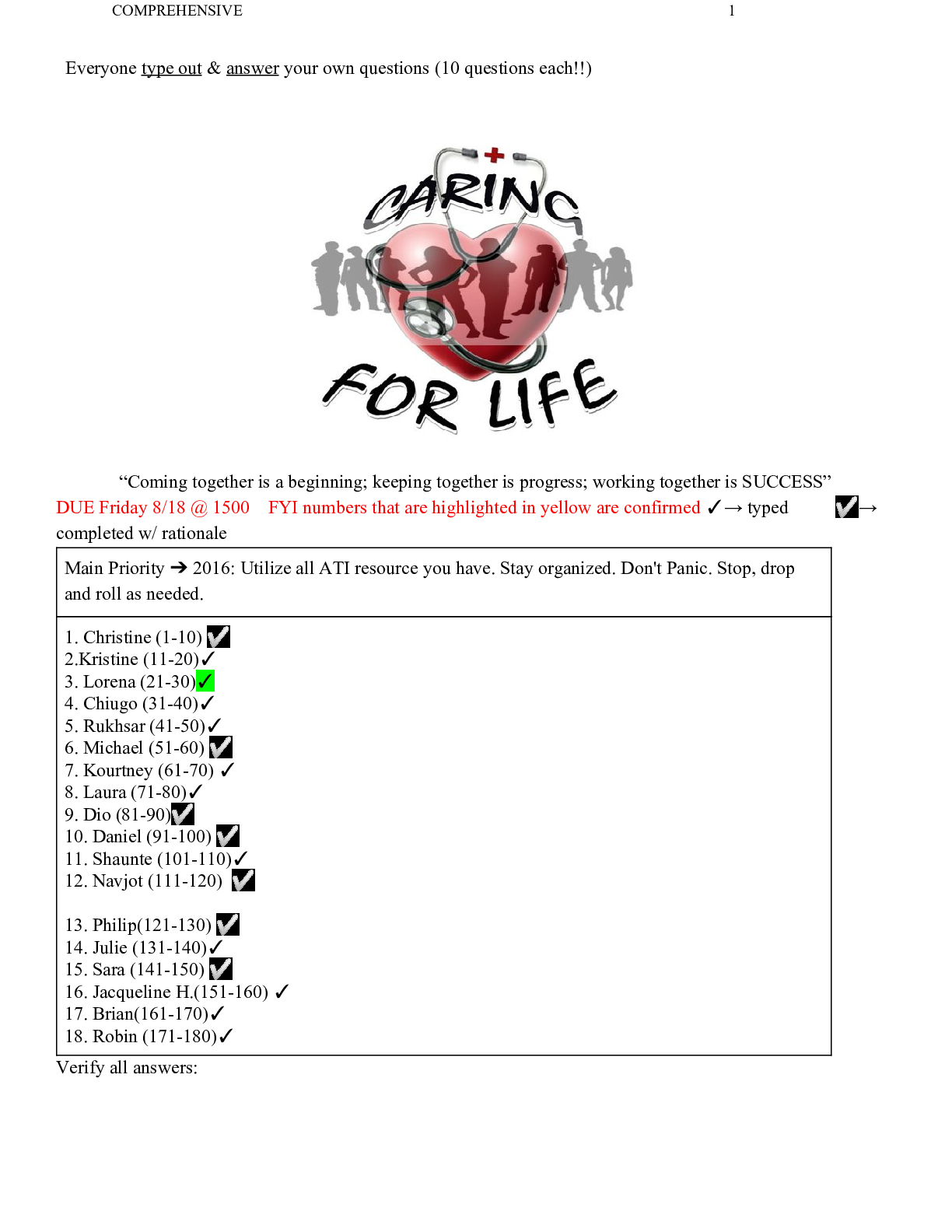
Buy this document to get the full access instantly
Instant Download Access after purchase
Buy NowInstant download
We Accept:

Reviews( 0 )
$22.50
Can't find what you want? Try our AI powered Search
Document information
Connected school, study & course
About the document
Uploaded On
Jun 22, 2021
Number of pages
46
Written in
All
Additional information
This document has been written for:
Uploaded
Jun 22, 2021
Downloads
0
Views
116

